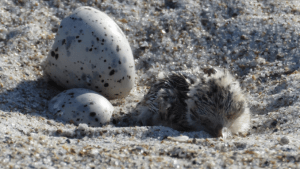Wildlife Commission Asks Beachgoers to Watch for Nesting Birds

Waterbird nesting is now underway along the coast, and biologists with the N.C. Wildlife Resources Commission urge people to watch where they step on the beach because these birds are very sensitive to human disturbance. Eggs and chicks are well camouflaged and can be unintentionally stepped on and crushed by humans and pets. Getting too close to a nesting bird can cause it to fly off, leaving the eggs or chicks vulnerable to the elements or to predators.
“Birds have their ways of letting you know when you’re too close,” said Carmen Johnson, the Wildlife Commission’s waterbird biologist. “They’ll call loudly and dive at you. Some species will pretend to have a broken wing to lure you or other perceived predators away from the nest and chicks.”
Because beachgoers may not recognize bird-nesting habitats, the Wildlife Commission asks the public to observe the black-and-white signs posted by the agency and signs posted by agency partners around important beach-nesting areas and islands. The signs help people avoid nesting grounds from April 1 through Aug. 31 — the sensitive nesting and brood-rearing season — and advise that entering an area can result in the loss of eggs or chicks.
Wildlife Commission staff also remind boaters to be mindful of nesting birds on islands, particularly if they approach an island posted with the black-and-white signs.
“You can help North Carolina’s waterbirds have a successful nesting season by observing them from outside the posted areas, and avoiding islands marked as bird-nesting areas, or unmarked islands where you see nesting birds,” Johnson said. “Some birds nest near the high tide line, and the likelihood of disturbing nests and stepping on flightless chicks is high.”
Johnson added that it is especially important to adhere to the ‘no dogs’ rule on the signs. Not only is it the law, but one dog can destroy an entire bird nesting colony in minutes.
Some islands that serve as beach-nesting habitat are not marked with black-and-white signs, such as many of the state’s marsh islands in the sounds. Johnson recommends that people give these islands a buffer between their activities and any nesting birds.
Likewise, not all nesting areas on the beach are posted, so coastal visitors and residents should be always aware of their surroundings.
Beachgoers can help protect nesting shorebirds are by:
- Keeping dogs on a leash at all times. Dogs may chase and harass birds, as well as trample nests, killing chicks or crushing eggs.
- Following the beach driving regulations. If driving is permitted, only drive on the lower part of the beach and drive slowly enough to avoid running over chicks.
- Disposing of trash properly when leaving the beach, including bait and scraps from cleaned fish, which can attract predators such as gulls, raccoons, feral cats and foxes.
- Discarding fishing line and kite string in an appropriate receptacle. These materials can entangle and kill birds and other wildlife if left on the beach.
- Abstaining from feeding gulls. Gulls are a major predator of young chicks and eggs.
- Avoiding flying drones and kites near nesting colonies. They may be mistaken for a predator.
Cooperating with these simple steps and observing the posted signs will protect valuable bird resources and preserve our amazing beaches and wild waterfronts.
For more information about beach-nesting waterbirds and how to protect them, download the “North Carolina’s Beach-Nesting Birds” document or visit the conserving webpage.












